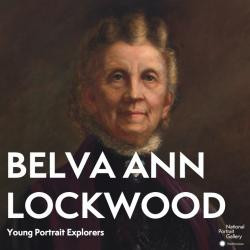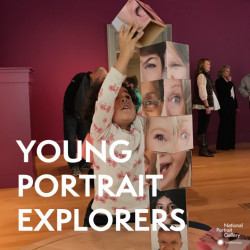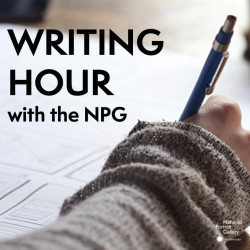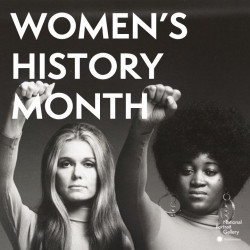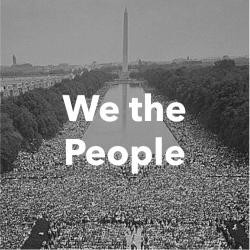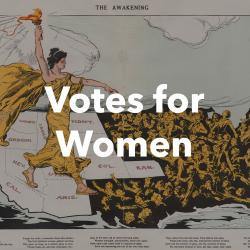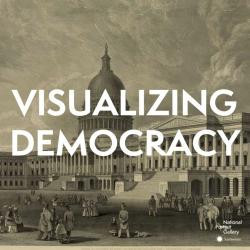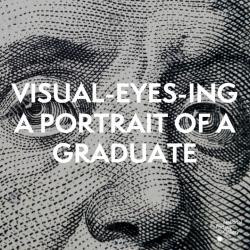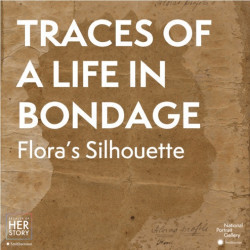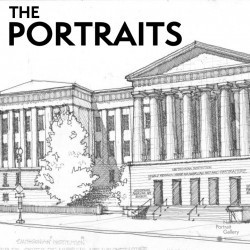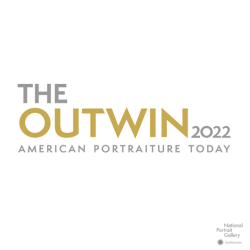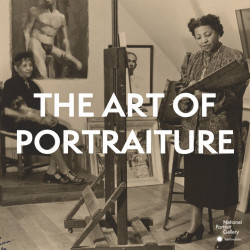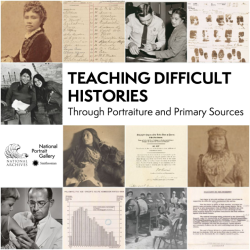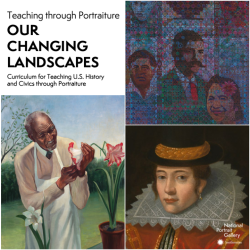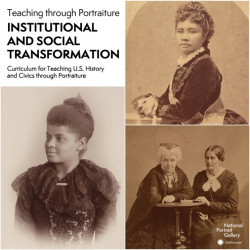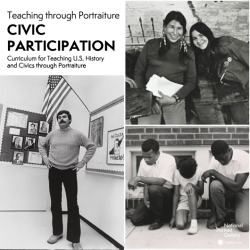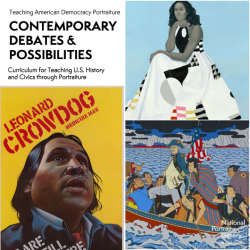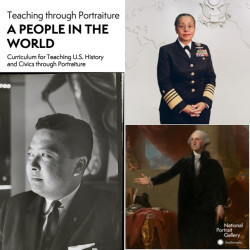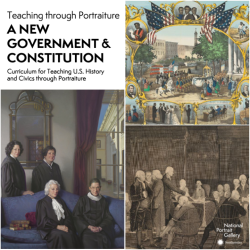Nicole Vance's collections
Young Portrait Explorers: Belva Ann Lockwood
<p><strong>Learning Objective: </strong>Learn about Belva Lockwood’s contribution to American history.</p>
<p><strong>Keywords</strong>: Belva Ann Lockwood, Young Portrait Explorers, Suffrage, Famous Women, American Women, Diploma, Lawyer, Graduation, Votes for Women, Supreme Court</p>
<p>#NPGteach</p>
 Nicole Vance
Nicole Vance
24
Young Portrait Explorers
<p>Explore portraits of astronauts and activists, scientists and star athletes—and discover the stories behind them! Use the following collections to engage young learners with portraiture through close looking, movement, and art-making.</p>
<p>Choose a portrait, open the collection, and explore art, history, biography and more!</p>
<p>#NPGteach</p>
 Nicole Vance
Nicole Vance
66
Writing Hour with the National Portrait Gallery
<p>Explore portraiture through storytelling and creative writing! Writing Hour with the National Portrait Gallery is a space where writers can create, connect, and draw inspiration from the museums collection. We recommend you spend some time reading your chosen portrait before writing. New to reading portraiture? Learn about interpreting portraiture through the elements of portrayal in <a href="https://www.youtube.com/watch?v=7xU8wC7sQl8&list=PLoiUVJmnCbmCsHkQlMj1Lr4YOfEh27OML&index=6">this video</a>. </p>
<p>This Learning Lab collection features writing prompts created by literary host, Willona Sloan. Discover new portraits through writing by joining us virtually every Tuesday from 5:00pm-6:00pm EST for Writing Hour with the National Portrait Gallery. Register <a href="https://www.eventbrite.com/e/virtual-writing-hour-with-the-national-portrait-gallery-tickets-99411309904">here</a>.</p>
<p>#NPGteach<br></p>
 Nicole Vance
Nicole Vance
112
Votes for Women: A Portrait of Persistence
<p>Take a close look at the portraits and objects within “Votes for Women: A Portrait of Persistence” exhibition at the National Portrait Gallery. “Votes for Women” outlines the more than 80-year movement for women to obtain the right to vote as part of the larger struggle for equality that continued through the 1965 Civil Rights Act and arguably lingers today. This Learning Module highlights figures such as Lucy Stone and Alice Paul, but also sheds light on the racial struggles of the suffrage movement and how African American women, often excluded by white women from the main suffrage organizations, organized for citizenship rights (including the right to vote).</p>
<p>#NPGteach</p>
<p>#BecauseOfHerStory</p>
 Nicole Vance
Nicole Vance
47
Voices of Social Justice
<p>This Learning Lab complements the National Portrait Gallery's 2021-2022 student program, Voices of Social Justice.<br></p>
<p>Students will learn about some of the major figures who struggled to obtain civil rights for disenfranchised or marginalized groups. They will listen to stories of social justice and analyze portraits of individuals who broke barriers—from key nineteenth-century reformers to modern leaders—and will likely be encouraged to consider how they, too, can become civically engaged.</p>
<p><a href="https://npg.si.edu/teachers/school-groups">Schedule</a> a virtual Voices of Social Justice student program with National Portrait Gallery educators.</p>
<p>#NPGteach</p>
<p>Keywords: Social Justice, Activists, Civil Rights, Reform, Change, Disenfranchised, Abolition, Suffrage, Labor Rights, Citizenship Rights, Japanese Incarceration, Boycotts, Protest, March, Justice, Black Lives Matter</p>
 Nicole Vance
Nicole Vance
90
Visualizing Democracy
<p>This Learning Lab complements the National Portrait Gallery's student program, Visualizing Democracy. </p>
<p>Students will visualize democracy from the colonial era to the 21st century by analyzing portraits of major figures who played a critical role—as government officials, engaged citizens, or both—in creating a democratic society for the United States. Students will investigate how portraiture can convey democratic ideals and how, as a cultural institution housed in a historic building, the National Portrait Gallery has been and continues to be relevant to American democracy.</p>
<p><strong>Objectives</strong></p>
<p>After completing this lesson, students will be better able to: </p>
<ul><li>Identify key components of a portrait and discuss what one can learn about the sitter through these components. </li><li>Analyze the history of portraiture and understand how it has evolved from a means to document wealthy individuals to an accessible art form used to represent people from all walks of life. </li><li>Understand the nuance of the word democracy, to comprehend how portraiture’s evolution (the democratization of portraiture) has helped democratize society by giving voice to individuals who have historically been underrepresented. </li><li>Discuss the three branches of federal government and the value of citizen involvement in a democracy. Analyze the legacy of individuals who have been instrumental in creating, improving, and maintaining American democracy. </li><li>Recognize and analyze how cultural institutions, like the National Portrait Gallery, are important components of a robust democracy. </li></ul>
<p><a href="https://npg.si.edu/teachers/school-groups">Schedule</a> a virtual Visualizing Democracy student program with National Portrait Gallery educators.</p>
<p>#NPGteach<br></p>
<p></p>
 Nicole Vance
Nicole Vance
72
The Outwin 2022: American Portraiture Today
<p>Explore portraits from <em>The Outwin 2022: American Portraiture Today </em>at the National Portrait Gallery in this Learning Lab collection.</p>
<p><em></em><em>The Outwin 2022: American Portraiture Today</em> presents 42 portraits selected through an open call that garnered more than 2,700 entries from artists working across the United States and Puerto Rico. The artists responded with works that engage contemporary society, many providing new insights into the unprecedented reality we have experienced in the time surrounding the COVID-19 pandemic.</p>
<p>The selected finalists create artworks in a wide range of media, including painting, drawing, photography, sculpture, textiles, video, and performance. They demonstrate how capacious and changing the genre of portraiture can be, and illuminate the genre's power to make visible a multitude of life experiences.<br></p>
<p>To best view the video and performance pieces, visit the <em>The Outwin 2022: American Portraiture Today</em><em>'s </em><a href="https://portraitcompetition.si.edu/exhibition/2022-outwin-boochever-portrait-competition/?lang=eng">website</a>.</p>
<p>Every three years, the National Portrait Gallery invites both emerging and established artists working in the U.S. to submit a recent portrait to the Outwin Boochever Portrait Competition. Around fifty works are then selected by expert jurors who, on average, review more than 2,500 entries. The competition has evolved since its inception in 2006 to include performance art and time-based media alongside painting, photography, drawing, and sculpture.</p>
<p>As part of its deep commitment to supporting contemporary artists working in portraiture, the National Portrait Gallery looks to the Outwin to share the genre’s remarkable relevance and strengthen the visual representation of American history. Each iteration of the competition gauges portraiture’s progression while underscoring the potential of one person to make an impact.</p>
<p>The Outwin is made possible through the Virginia Outwin Boochever Portrait Competition Endowment, established by Virginia Outwin Boochever (1920–2005), who served as a docent for the National Portrait Gallery for nearly two decades. Mrs. Boochever’s vision for the Outwin is now carried out by her children.</p>
<p>Educators, to explore these portraits with your students through close looking and visible thinking routines, see the resources at the end of this collection for ideas.</p>
<p>#NPGteach</p>
 Nicole Vance
Nicole Vance
60
The Four Justices: Young Portrait Explorers
<p>Learn about the four women justices who have served on the Supreme Court (the highest or most important court of law in the United States).</p>
<p>#NPGteach</p>
<p>Keywords: Supreme Court, Women, Justices, Judges, Sandra Day O'Connor, Ruth Bader Ginsburg, Elena Kagan, Sonia Sotomayor</p>
 Nicole Vance
Nicole Vance
30
The Art of Portraiture
<p>This Learning Lab Collection complements the National Portrait Gallery student program, The Art of Portraiture.</p>
<p>Students will take a close look at modern and contemporary portraiture through the lens of artists’ decisions, paying particular attention to the different approaches that artists take to their subject matter and the different processes that they use in making their art.<br></p>
<p>#NPGteach<br></p>
<p>Objectives:</p>
<ul><li>Examine modern and contemporary portraiture and identify, compare, and contrast visual elements in the portrait.</li><li>Identify and analyze the contributions of modern and contemporary Americans to U.S. history and society.</li><li>Discuss the specific choices an artist has made in his or her portraits.</li><li>Discuss the relevancy of portraiture as a contemporary art form.</li></ul><p>Learn more about our <a href="https://npg.si.edu/teachers/school-groups">virtual 2020-2021 student programs</a> and explore more of the <a href="https://learninglab.si.edu/org/npg">National Portrait Gallery's Learning Lab collections</a>.</p>
<p>Keywords: Portraiture, Painting, Sculpture, Photography, Mixed Media, Video Art, Engraving, Printmaking, Artist, Contemporary, Artistic Style, Symbols, Biography, Self-Portrait</p>
<p></p>
 Nicole Vance
Nicole Vance
48
Teaching American Democracy through Portraiture: Our Changing Landscapes
<p>In this Learning Lab collection, portraits from the sixteenth to twenty-first centuries are used an entry points to teach about the importance of place in civics. Throughout this collection, students will examine not only the portrait subjects but will also gain insight into the larger historical time period in which the subjects lived and how they made change in their communities and the United States. <br></p>
<p>This collection contains three lessons that highlight activists: "Reading Portraiture: Lenses for Dialogue," "Engaging History: The Return to Atzlán," and "Connections to the Present: Environments of Change."</p>
<p>Review Reading Portraiture 101 before beginning the lessons.</p>
<p>#NPGteach #EducatingForDemocracy</p>
 Nicole Vance
Nicole Vance
46
Teaching American Democracy through Portraiture: Institutional and Social Transformation
<p>In this Learning Lab collection, portrait photography of nineteenth century women including Susan B. Anthony, Elizabeth Cady Stanton, Queen Lili'uokalani, and Ida B. Wells are used as entry points to teach about institutional and social transformation. Throughout this collection, students will examine not only the portrait subjects but will also gain insight into the larger historical time period in which the subjects lived and how they navigated and made change in their communities and the United States.<br></p>
<p>This collection contains three lessons that highlight activists: "Reading Portraiture: Women’s Suffrage in 3D," "Primary Perspectives on Hawaii," and "Connections to the Present: Changemaker Conversations."</p>
<p>Review Reading Portraiture 101 before beginning the lessons.</p>
<p>#NPGteach #EducatingForDemocracy</p>
 Nicole Vance
Nicole Vance
46
Teaching American Democracy through Portraiture: Civic Participation
<p>In this Learning Lab collection, portrait photography of twentieth-century activists<em> </em>is used as an entry point to teach about the civic participation. Using <a href="https://www.educatingforamericandemocracy.org/">Educating for American Democracy</a>'s roadmap as a guide, this lesson centers on the theme <a href="https://www.educatingforamericandemocracy.org/the-roadmap/7themes/">Civic Participation</a>. . Students will examine not only the portrait subjects--including Ona Kingbird, John Lewis, and Sal Castro--but will also gain insight into the larger historical time period in which the subjects lived and how they located agency, made change, and sustained ideals of American democracy.</p>
<p>This collection contains three lessons that highlight activists: "Reading Portraiture: See – Think – Me - We," "Engaging History: Student Nonviolent Coordinating Committee," and "Connections to the Present: Students in Action" with the last lesson containing an artmaking prompt for Educating for American Democracy's Design Challenge: <a href="https://www.educatingforamericandemocracy.org/the-roadmap/5designchallenges/">Motivating Agency, Sustaining the Republic</a></p>
<p>Review <a href="https://learninglab.si.edu/collections/reading-portraiture-101/6VeUfzDnKE87HIOP">Reading Portraiture 101 </a>before beginning the lessons.</p>
<p>#NPGteach #EducatingForDemocracy</p>
<p></p>
 Nicole Vance
Nicole Vance
53

